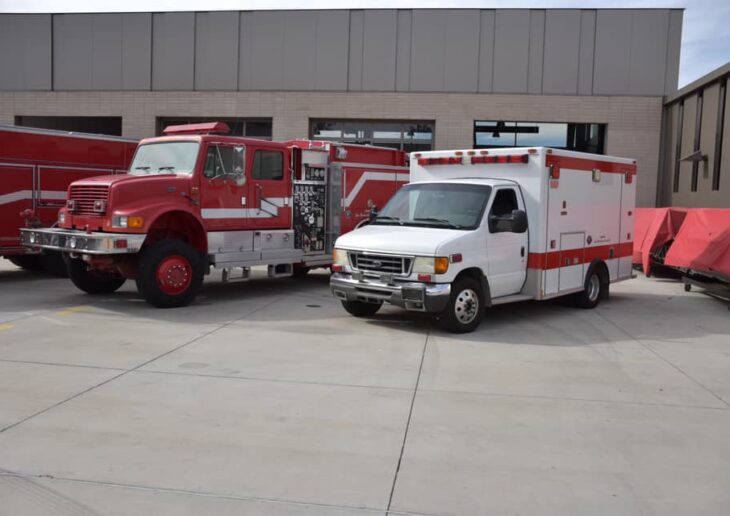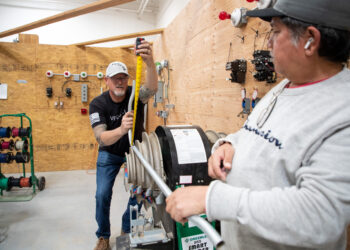
Culinary careers are sizzling again as the hospitality and restaurant industry bounces back from the pandemic and seeks to fill the positions vacated during the COVID-19 downturn. Chaffey College is doing its part to get more cooks in the kitchen.

In a state of constant emergency, it’s essential that first responders remain in a constant state of urgency.
Wildfire incidents are increasing in California, threatening land, homes and lives. Five of the state’s 20 largest-ever wildfires occurred in 2020, according to CAL FIRE. That same year, more than 10.3 million acres burned — more than double the territory lost in 2019.
“California’s wildfire ‘season’ is now year-round,” says San Bernardino County Fire Battalion Chief Mike McClintock. That’s why the department works closely with Crafton Hills College’s Fire Academy, which has stepped up to train future cadets to protect the region from the devastation of natural disasters.
The partnership spread fast, with SBCFD and CHC finding mutual benefit in a workforce-ready firefighter training program. When the chief realized that the College lacked a wildland fire apparatus in its fleet, the department donated a Type III Brush Engine, as well as wildland fighting equipment and an ambulance to keep the essential talent pipeline moving into the future.
The two new vehicles will join three previously donated fire engines from
County Fire, helping cadets hone life-saving skills on industry-standard equipment.
“Crafton Hills College… has educated and trained hundreds of our firefighters and paramedics,” shares the industry partner, confident that the College will put the equipment to good use. As an Academy alum, McClintock appreciates the College’s top-notch training firsthand. “Crafton gave me the tools and certificates to successfully apply for a firefighter job. The instructors were instrumental in setting me up for success.”
Like McClintock, Crafton Academy’s Fire Chief Mike Alder is also an alum of the program, as well as a former firefighter with San Bernardino County Fire.
“We’re kind of connected at the hip with local fire agencies,” says the grateful instructor, a firefighter since 1983. “That relationship with our advisory committee and the local fire agencies goes all the way back to the early 80s.
“We’re really proud of that because they have been such an inspiration to us.”
A central component of the 18-week Academy is Basic Wildland Fire training. In the past, the program always had to borrow CAL FIRE’s wildland engine to simulate the real-world experience properly. Thanks to SBFCD’s donation, cadets can burn rubber to burning shrubbery in their very own vehicle.
“Now, we have a state-of-the-art piece of equipment that can be used for that wildland section of the Academy and all the testing processes,” beams Alder. According to the fire chief, the 1999 International/Pierce “Fire Hawk” Type III Engine carries 500 gallons of water and can “pump and roll,” essential for wildland firefighting.
“It’s going to be a real shot in the arm for us and a tremendous benefit to the cadets,” he predicts.
Alder recalls how, when he was a chief officer at County Fire, he helped design engines – including Crafton’s most recent acquisition – as part of the apparatus committee. “After all these years, for the engine that I was responsible for building to come back is really neat.”
County Fire also donated a full complement of industry-standard wildland equipment, including hose, tools and packs. Just in time, Alder says, as capacity and attendance in the Academy increases. With the addition of the engine and the supplies, even more cadets will have the opportunity to earn the sought-after wildland certificate.
“I can’t even put a price tag on how important this need is,” says Alder. “The proof in the pudding is that a lot of our fire cadets, as soon as they graduate, they get picked up within weeks to months.”
The College runs two Fire Academies every year, serving a maximum of 30 cadets per cohort. The intensive program runs four days a week, 12 hours a day, for 18 solid weeks, giving students the practical training they need to start in-demand careers.
“The Baby Boomer generation has left this massive void in the fire service that they can’t fill fast enough,” says Alder. “A lot of young men and women are realizing, ‘Hey, not only can I get the training, but the jobs are available out there.’”
According to cadet Jessica Renfrow, who craved a high-energy career in service of her community, Crafton Hills College offered the whole package.
“This program taught the necessary skills I needed to be successful, and also worked to instill core values such as teamwork, integrity and determination,” says the brave student, who gained not only the certification but the confidence she needed to serve. After all, on the job, she says, “You are turning around and running toward the danger, toward what everyone else is running from.”
Her instructor tends to agree.
“Firefighters make a good healthy living,” says Alder, but “it has never been about the money… This entire job is about giving back to the community.”
On the Emergency Medical Services side of the College, programs like Paramedic and Emergency Medical Technician will also greatly benefit from the new 2005 Ford/Medtec Ambulance.
“To have that ambulance donated to us… is going to allow for our students to be submerged into the scenario and feel as though they’re out on an apparatus and actually running those 911 calls,” says Paramedic Director Amanda Ward. From practicing loading patients to administering aid while on the move, she says, “it’s really going to ramp up that realistic area of the simulation.”
The director started in EMS when she was 18 years old and graduated from Crafton’s Paramedic Program in 2007. So, she knows from experience just how in-demand her students are.
“More than 90 percent of our Paramedic students are hired the moment they come out of our program,” says Ward. “There are actually way more open positions than there are paramedics to fill them.”
The program graduates about 50 students a year, running two classes annually. The year-long course load includes a clinical phase in which students work with nurses and physicians in a hospital setting. Once that’s complete, they fulfill a 600-hour field assignment alongside active paramedics.

“We have amazing students that are very dedicated to this field,” says the director. “That is where you see those high success rates and higher ability.”
Ward references students like Daniel John O’Connell. Born and raised in Yucaipa, he spent four years in the Marine Corps as a machine gunner and is now studying to become an emergency medical technician.
“I decided on EMT because I wanted to be able to help people,” says the career frontliner. “We pride ourselves on making the world a better place.”
For O’Connell, the best part about the job is knowing that he can aid those in distress and possibly save lives. He credits his can-do attitude not only to his military experience but to his college:
“By going to Crafton Hills College, I will have more experience than most because the program here is very detail-oriented. It’s a lot of hands-on and really getting to know your job.”
That kind of preparedness is what Dave Molloy, Operations Manager at American Medical Response in Redlands, prioritizes most when seeking new additions to his team.
“I hire people from Crafton Hills College all the time,” says the CHC Paramedic Program alum, EMS adjunct faculty member, and industry partner. “If an EMT or paramedic is coming from Crafton College and applying for a job here, I know the solid training they’ve had.”
And now, thanks to the College’s industry partner San Bernardino County Fire, students will be more prepared than ever before to keep the community safe.
“We are excited to continue a great relationship with the College,” says McClintock. “The donation shows our commitment to the College and the future firefighters.”
Sources:
https://www.fire.ca.gov/stats-events

Culinary careers are sizzling again as the hospitality and restaurant industry bounces back from the pandemic and seeks to fill the positions vacated during the COVID-19 downturn. Chaffey College is doing its part to get more cooks in the kitchen.

Dual Enrollment (DE) is catching on as students and their families recognize the advantages of earning college credit while still working towards high school graduation. But students aren’t the only… Read More – Good News for Community Colleges: Dual Enrollments Are on the Rise

Enrollment in courses not offering credit toward a degree or certificate are outpacing for-credit programs in some states (Fed Communities). And it’s no wonder. With the convenience, minimal time commitment,… Read More – No Credit, No Problem: Noncredit Courses Gain Steam